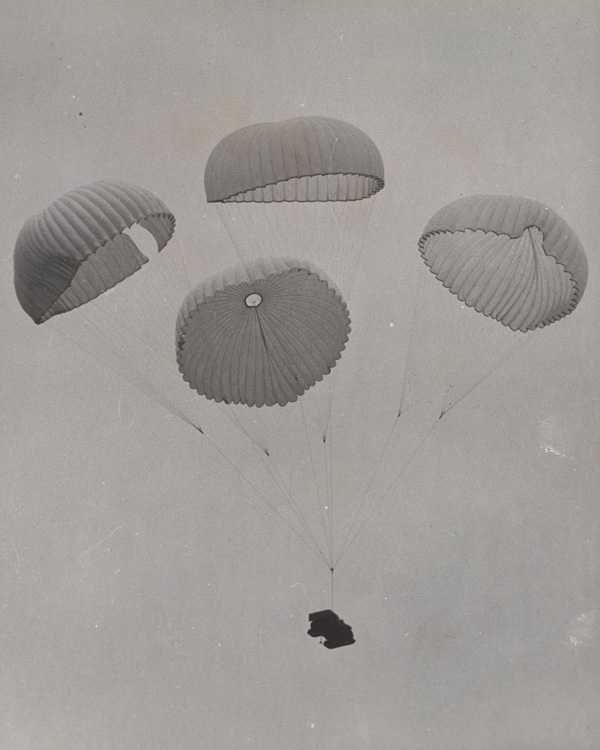How do parachutes work?
Parachutes work because of air resistance. If there were no air resistance, then gravity would cause everything to fall at the same rate. So, no matter what you dropped from a plane (whether a feather or a paratrooper), it would hit the ground at exactly the same time.
A parachute needs to be light (to carry), foldable (for packing) and flexible (for steering), but also strong and tear-resistant (for safety). It also has to be carefully folded - or packed - to ensure that it will open reliably. If a parachute is not packed properly it can result in a malfunction where the main parachute - or canopy - fails to deploy correctly or fully.
Quiz
Where was the largest mass deployment of soldiers by parachute?
The biggest airborne operation in history took place in the Netherlands between 12 and 25 September 1944. Operation Market Garden saw over 20,000 Allied troops dropped by parachute. Another 14,000 men landed by glider.
What is parachuting for?
At its most basic, military parachuting is about delivering soldiers and supplies into action. It involves jumping out of a plane, waiting for the canopy to open automatically from a 'static line' attached to the aircraft, and then hoping the wind is blowing in the right direction.
More experienced parachutists, such as in the Special Forces, also use steerable chutes that they deploy themselves at whatever altitude is required. Their square parachutes are more manoeuvrable than the standard round static-line chutes and are used for precision landings.
Hairiest paratroopers?
During the Second World War (1939-45), some British paratroopers were accompanied by dogs - mostly German shepherds - trained to parachute alongside them. They were used for mine-detecting, guard and patrol duties.
'Para Dogs' went into action on D-Day (6 June 1944). One dog, called ‘Bing’, landed in a tree where he remained until his handler could rescue him the next morning!
Special Air Service (SAS) troops serving in Afghanistan (2001-14) sometimes parachuted into action with German shepherd dogs strapped to their chests. They were fitted with video cameras to help soldiers search buildings for enemies.
Quiz
What's the heaviest thing ever parachuted into action?
Craftiest use of parachutes?
During the D-Day landings of June 1944, the Allies dropped thousands of 'paradummies' over Normandy. These were dolls that looked like paratroopers and were intended to trick the enemy into directing their troops away from areas where genuine air drops were happening.
Many were designed to explode when they hit the ground in the hope that the Germans might think they were under fire. SAS soldiers were dropped alongside some of the British dolls and played recordings of battle noise to further confuse the enemy.
Luckiest parachute escape?
Survival expert Bear Grylls served in the Special Forces Reserve from 1994 to 1997. At the age of 21, his military career was cut short by a parachuting accident while training with the SAS in Africa.
On a routine jump, his parachute split at 1,600 feet (500m). He fell and landed on his back, fracturing three vertebrae. Incredibly, his spinal cord remained intact, and after 18 months of military rehabilitation, he was discharged.
Quiz
What's the world record for the highest parachute jump?
The highest parachute jump of all time took place in October 2014. Wearing a specially designed spacesuit, Alan Eustace leapt from a balloon just over 25 miles (40 km) above the earth. He then skydived for about 4.5 minutes, reaching a speed of over 800mph before deploying his parachute at 18,000 feet (about 3.5 miles).
Parachute specialisms?
Some members of the SAS are trained in High Altitude Low Opening (HALO) jumping. This involves parachuting from 30,000 feet or more - that's the height most passenger jets fly! They do this to avoid being seen from the ground. They freefall most of the way down, deploying their parachutes at the last minute before landing. HALO jumpers wear special helmets and have to breath from oxygen bottles on the descent.
The Special Forces also use High Altitude High Opening (HAHO) parachuting. This involves expert parachutists deploying their steerable chutes at a high altitude. They can then glide long distances to their target and get to areas of enemy territory that it would be too dangerous to fly a plane over. Like HALO jumpers, HAHO parachutists have to breath bottled oxygen during their descent.
Members of the Special Boat Service (SBS) are trained to parachute into the sea, this is known as 'wet jumping'. The men, all expert swimmers as well as parachutists, are often dropped with boats. They then swim to these, attach outboard motors, and proceed with their mission.









